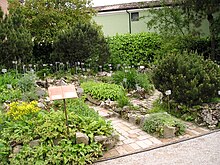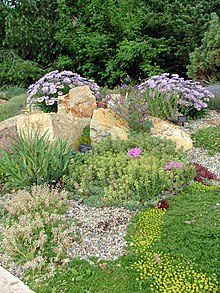Alpine garden

An alpine garden (or alpinarium, alpinum) is a domestic or botanical garden specialising in the collection and cultivation of alpine plants growing naturally at high altitudes around the world, such as in the Caucasus, Pyrenees, Rocky Mountains, Alps, Himalayas and Andes.
An alpine garden tries to imitate the conditions of the plants' place of origin. One example of this is using large stones and gravel beds, rather than the soil that naturally grows there. Though the plants can often cope with low temperatures, they dislike standing in damp soil during the winter months. The soil used is typically poor (sandy) but extremely well-drained. One of the main obstacles in developing an alpine garden is the unnatural conditions which exist in some areas, particularly mild or severe winters and heavy rainfall, such as those present in the United Kingdom and Ireland. This can be avoided by growing the plants in an alpine house or unheated greenhouse, which tries to reproduce the ideal conditions. The first true alpine garden was created by Anton Kerner von Marilaun in 1875 on the Blaser Mountain, in Tyrol, Austria, at an altitude of 2,190 m (7,190 ft).[1]
Vegetation[]
Typical plants found in an alpine garden include:[2]
- Androsace
- Arabis alpina (rock cress)
- Campanula - alpine species
- Dianthus - alpine species
- Gentiana
- Geranium dalmaticum (cranesbill)
- Globularia
- Iberis sempervirens (candytuft)
- Leontopodium
- Phlox subulata
- Pulsatilla vulgaris (pasque flower)
- Primula - alpine species
- Ranunculus (buttercup)
- Rhodanthemum hosmariense
- Saxifraga - alpine species
- Scutellaria orientalis (helmet flower)
- Sedum spathulifolium (stonecrop)
- Sisyrinchium
- Thymus (thyme)
Botanical high gardens with an alpine house or garden[]


- Austria
- Belgium
- France
- Jardin des Plantes
- Jardin botanique alpin du Lautaret
- Jardin botanique alpin La Jaÿsinia
- Germany
- Botanischer Erlebnisgarten Altenburg
- Botanical Garden in Berlin
- Botanischer Garten Bielefeld
- Botanischer Garten Düsseldorf
- Botanischer Garten Gießen
- Botanischer Garten der Johann Wolfgang Goethe-Universität Frankfurt am Main
- Botanischer Garten München-Nymphenburg
- Botanischer Garten Münster
- Botanischer Garten Marburg
- Botanischer Garten Potsdam
- Botanischer Garten der Ruhr-Universität Bochum
- Italy
- Slovenia
- The Netherlands
- Hortus Botanicus Amsterdam
- United Kingdom
- United States
See also[]
References[]
- ^ Alpine garden in Austria-Forum (in German) (at AEIOU)
- ^ Collins complete garden manual. United Kingdom: HarperCollins. 1998. p. 290. ISBN 0004140109.
External links[]
- (in English) Alpine Garden Society
- (in English) North American Rock Garden Society
- (in English) Scottish Rock Garden Club
- (in English) New Zealand Alpine Garden Society
- (English) Alpine Garden Society - Dublin Group - Home Page
- (in Dutch) Nederlandse Rotsplanten Vereniging
- (in Dutch) Vlaamse Rotsplanten Vereniging
- Making a Rock Garden by Henry Sherman Adams, 1912
 Making a Rock Garden public domain audiobook at LibriVox
Making a Rock Garden public domain audiobook at LibriVox
- Botanical gardens
- Botany stubs
